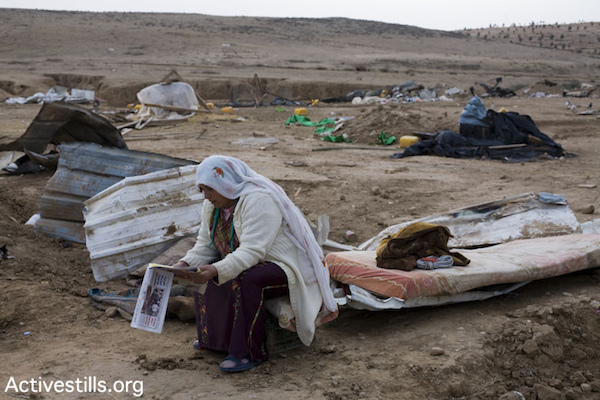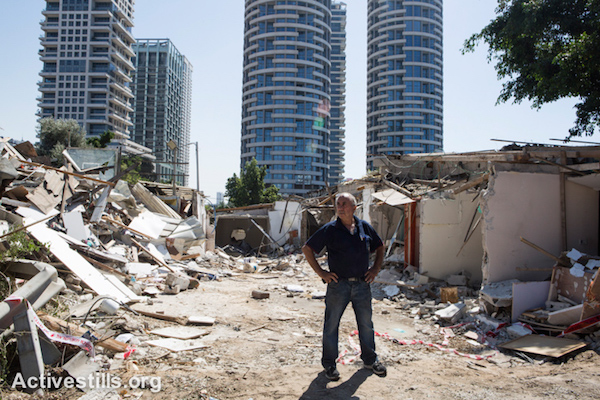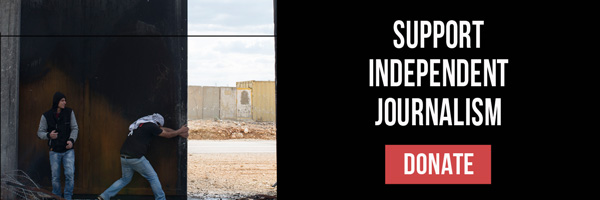Corruption does not begin with Netanyahu’s cigars or pink champagne. It begins with an ideological system that sees entire segments of the population as undesirable and unnecessary, and as temporary residents in their own homes.

Last night, a striking episode in Amnon Levy’s documentary series, “The Real Faces,” aired on TV. The episode followed the residents of the Tel Kabir, Givat Amal, and HaArgazim neighborhoods, whom the government has designated as trespassers in their own homes. The government is now trying to evict them, to the benefit of real estate tycoons.
Yesterday, a court in Be’er Sheva convicted Sheikh Siakh A-Turi, 68, of trespassing, sentencing him to ten months in prison with a fine of 36,000 shekels. Sheikh Siakh, is a resident of the Bedouin village of Al-Araqib.
The residents of Givat Amal and Al-Araqib share the same tragic fate: they are among the most marginalized people in a country whose government has declared them trespassers on land on which they have lived for decades. In both instances, the government prevented them from formalizing their property ownership by a range of deceptive means. The government, in contrast, moved quickly to formalize and recognize the ownership of those citizens whom it actually values, in some cases spitting distance from where these “trespassers” live.
To truly believe these stories, you must hear them again and again. The Mizrahi residents of these Tel Aviv neighborhoods could not formalize their ownership of the land on which they have lived for 70 years because they “missed” a small announcement in the Davar newspaper in 1951, inviting “any person who de facto owns, without a deed, an apartment or business on absentee property” to submit a request to formalize their ownership. Like their Ashkenazi neighbors—Mapai supporters and employees of the Tel Aviv municipality and the Custodian for Absentee Property—they, too, settled on property that belonged to Palestinians before 1948.
However, unlike their Ashkenazi neighbors, the Mizrahi residents had no way of hearing about an announcement published once in the Mapai party newspaper, and which allowed for a short window of two weeks to formalize property ownership. Those who read the announcement got recognized as legal landowners. Those who didn’t, didn’t; they continued to live in their houses without knowing that eventually, when their land had become desirable real estate, they could be declared “trespassers” in their own homes.
At the same time as the Israeli government was defrauding the residents of Tel Aviv’s Mizrahi neighborhoods, it was expropriating vast tracts of land in the Negev—permitted under a 1953 law to allow the government to easily seize land to promote “development, settlement, and security.” Residents of Al-Araqib were expelled by the government from their land, despite the fact that the land has since gone untouched; the government expropriated the land seemingly for no reason.
When Al-Araqib residents attempted to appeal the expropriation in court, the government refused even to hold a hearing. As Michal Rotem writes, “according to the state and its representatives, not only do the native inhabitants of the Negev lack ownership of the land, they lack even have the right to pursue their claim in court.”
Over the years, the residents of Al-Araqib have attempted to maintain their connection to the land, working their crops, watching their flocks, and burying their dead there. While lone farms — for Jews only — continue to proliferate in the region, since 2010, the government has destroyed the village of Al-Araqib 120 times.
Sheikh Siakh, a man nearing his 70s, will be imprisoned because he dared to resist this injustice. Perhaps it should comfort him that he was not shot to death by police, like Yaqub Musa Abu Al-Qian, killed in Umm Al-Hiran — a man whose only crime was attempting to get away from his village before it was destroyed so that a Jews-only town, Hiran, could be built in its place.
For months, thousands of people have joined the weekly protests against government corruption in Petah Tikvah and now Tel Aviv. But government corruption does not begin with Netanyahu’s graft investigations, nor with his cigars and rosé champagne.
Government corruption begins with an ideological system that works to demographically design the country’s territory according to the criteria of ethnic and national origin. Government corruption begins with a way of seeing entire segments of the population as unnecessary and undesirable, as temporary residents in their own homes. Government corruption begins with the criminal violence of calling people trespassers in their own houses. If we want to fight this deep moral corruption, the place to look is not Rothschild Boulevard or the Attorney General’s house, but the line that that connects Givat Amal to Al-Araqib.

This article first appeared in Hebrew at Local Call. Read it here.


